question :
A two terminal network consists of one of the RLC elements . The element is connected to an a.c. supply .The current through the element is I A.
When inductor is inserted in series between the source and element,the current through the element becomes 2I A . What is the element ?
(a)resistor
(b)An inductor
(c)A capacitor
(d)can not be a single element
answer : the answer is given (c) A capacitor but no explanation is given .
i'm confused how can inductor amplify current without presence of any active source in the network so, please provide explanation of answer for understanding concept behind the question . thank you.
EDIT:As per hilmer comment i break problem into three cases below is the pic attached for same

in first two cases (with R and L as elements respectively ) when inductor is inserted in series current is reducing(because denominator is +ve quantity and increases with increase in frequency ) ,but in 3rd case with capacitor as element there is scope of increase in current because denominator is(1-w^2*LC) which decreases with increase in frequency .
but how the current become 2 times is still my doubt? even if W^2*LC =1/2 then numerator will also change accordingly

Best Answer
this looks like homework, so I'm only going to give hints
EDIT based on the work done.
There nothing special about the number 2 here, it could 1.3, 20.5 or any other number. The only thing that's relevant is that it is larter than 1, and that means that the current gets bigger, not smaller.
You can simply look at the magnitude of the impedance and see if it goes up or down. Calling your inductor L0 we have
$$|Z_R| = \sqrt{R^2+(\omega L_0)^2}$$ $$|Z_L| = \omega(L+L_0)$$ $$|Z_C| = \omega L_0-1/(\omega C)$$
Compare this to the magnitude of the inductor alone, $$ \omega L_0 $$ In the first two cases, the magnitude of the impedance gets bigger, i.e. the current goes down. Only in the last case, the magnitude can get smaller (depending on the values of C and the frequency), so if the current gets bigger, it has to be a capacitor.